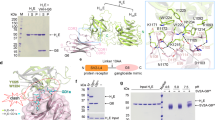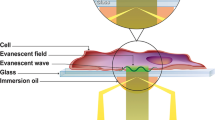Abstract
Botulinum neurotoxin (BoNY) type A, a causative agent of botulism, is a di-chain protein (molecular weight 140,000) from Clostridium botulinum, and the most neurotoxic substance known1. Some cases of sudden infant cot deaths have been attributed to such a neuroparalytic condition2. BoNT inhibits irreversibly the release of acetylcholine from peripheral nerves in a highly selective manner3–6. Hence, it is potentially an invaluable probe for studying the mechanism of transmitter release7,8. Here we demonstrate specific labelling of murine motor nerve terminals with neurotoxic, 125I-labelled BoNT (type A) by autoradiography. We observed saturable, temperature-sensitive binding of BoNT to sites which reside solely on the nerve terminal membrane; these were distributed on all unmyelinated areas, at an average density of 150–500 per µm2 of membrane. The binding was mediated by the larger summit of the toxin and was inhibited partially by tetanus toxin, another microbial protein9. No specific binding was detectable on any other cell types examined, including noradrenergic terminals. Following binding, internalization of radioactivity was observed; this process was energy-dependent as it could be prevented totally by aride or dinitrophenol (DNP). This direct demonstration of separable steps, including highly selective binding and acceptor-mediated internalization, is reconcilable with the unique potency and the multiphasic inhibitory action of BoNT on transmitter release, as shown electrophysiologically8.
This is a preview of subscription content, access via your institution
Access options
Subscribe to this journal
Receive 51 print issues and online access
$199.00 per year
only $3.90 per issue
Buy this article
- Purchase on Springer Link
- Instant access to full article PDF
Prices may be subject to local taxes which are calculated during checkout
Similar content being viewed by others
References
Sugiyama, H. Microbiol. Rev. 44, 419–448 (1980).
Arnon, S. S., Midura, T. F., Damus, K., Wood, R. M. & Chin, J. Lancet i, 1273–1276 (1978).
Gundersen, C. B., Katz, B. & Miledi, R. Proc. R. Soc. B 216, 369–376 (1982).
Sellin, L. C. & Thesleff, S. J. Physiol., Lond. 317, 487–495 (1981).
Tse, C. K., Dolly, J. O., Hambleton, P., Wray, D. & Melling, J. Eur. J. Biochem. 122, 493–500 (1982).
MacKenzie, I., Burnstock, G. & Dolly, J. O. Neuroscience 7, 997–1006 (1982).
Dolly, J. O. et al. in Biomedical Aspects of Botulism (ed. Lewis, G.) 47–64 (Academic, New York, 1981).
Simpson, L. L. Pharmac. Rev. 33, 155–188 (1981).
Wellhoner, H-H. Rev. physiol. biochem. Pharmac. 93, 1–68 (1982).
Williams, R. S., Tse, C. K., Dolly, J. O., Hambleton, P. & Melling, J. Eur. J. Biochem. 131, 437–445 (1983).
Dolly, J. O. et al. Tox. 20, 141–148 (1982).
Hirokawa, N. & Kitamura, M. Naunyn-Schmiedebergs Archs Pharmac. 287, 107–110 (1975).
Fertuck, H. C. & Salpeter, M. M. J. Cell Biol. 69, 144–158 (1976).
Dolly, J. O., Albuquerque, E. X., Sarvey, J. M., Mallick, B. & Barnard, E. A. Molec. Pharmac. 13, 1–14 (1977).
Burnstock, G. & Costa, M. in Adrenergic Neurons (Chapman and Hall, London, 1975).
Kozaki, S., Togashi, S. & Sakaguchi, G. Japan. J. med. sci. Biol. 34, 61–68 (1981).
Simpson, L. L. J. pharmac. exp. Ther. 212, 16–21 (1980).
Goldstein, J. L. Nature 279, 679–685 (1979).
Habermann, E. in Biomedical Aspects of Botulism (ed. Lewis, G.) 129–141 (Academic, New York, 1981).
Hanig, J. P. & Lamanna, C. J. theor. Biol. 77, 107–113 (1979).
Simpson, L. L. J. Pharmac. exp. Ther. 222, 43–48 (1982).
Leppla, S. H., Dorland, R. B. & Middlebrook, J.L. J. biol. Chem. 255, 2247–2250 (1980).
Hopkins, C. R. Nature 304, 684–685 (1983).
Author information
Authors and Affiliations
Rights and permissions
About this article
Cite this article
Dolly, J., Black, J., Williams, R. et al. Acceptors for botulinum neurotoxin reside on motor nerve terminals and mediate its internalization. Nature 307, 457–460 (1984). https://doi.org/10.1038/307457a0
Received:
Accepted:
Issue Date:
DOI: https://doi.org/10.1038/307457a0
This article is cited by
-
Neuronal entry and high neurotoxicity of botulinum neurotoxin A require its N-terminal binding sub-domain
Scientific Reports (2017)
-
Botulinum neurotoxins: genetic, structural and mechanistic insights
Nature Reviews Microbiology (2014)
Comments
By submitting a comment you agree to abide by our Terms and Community Guidelines. If you find something abusive or that does not comply with our terms or guidelines please flag it as inappropriate.



